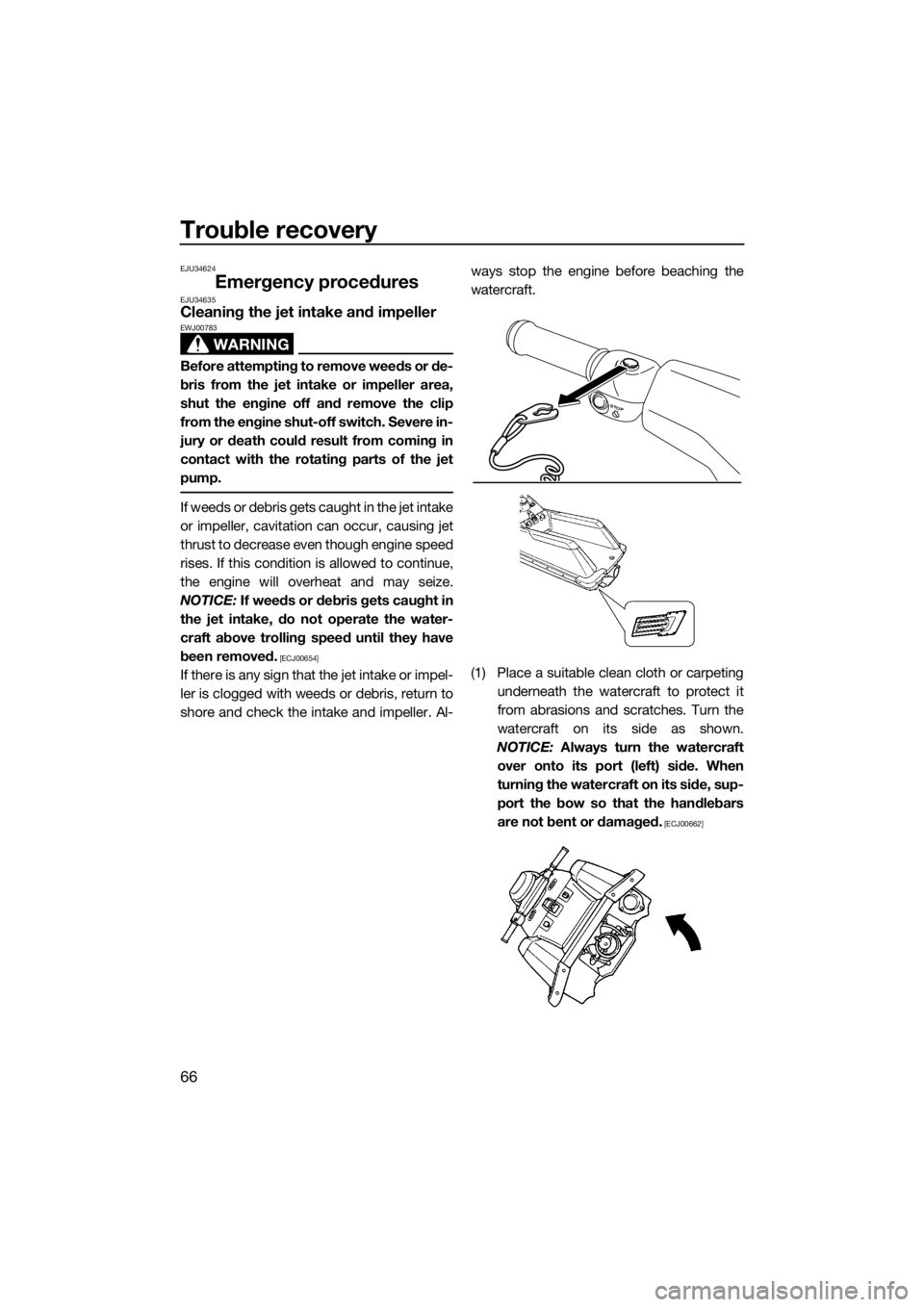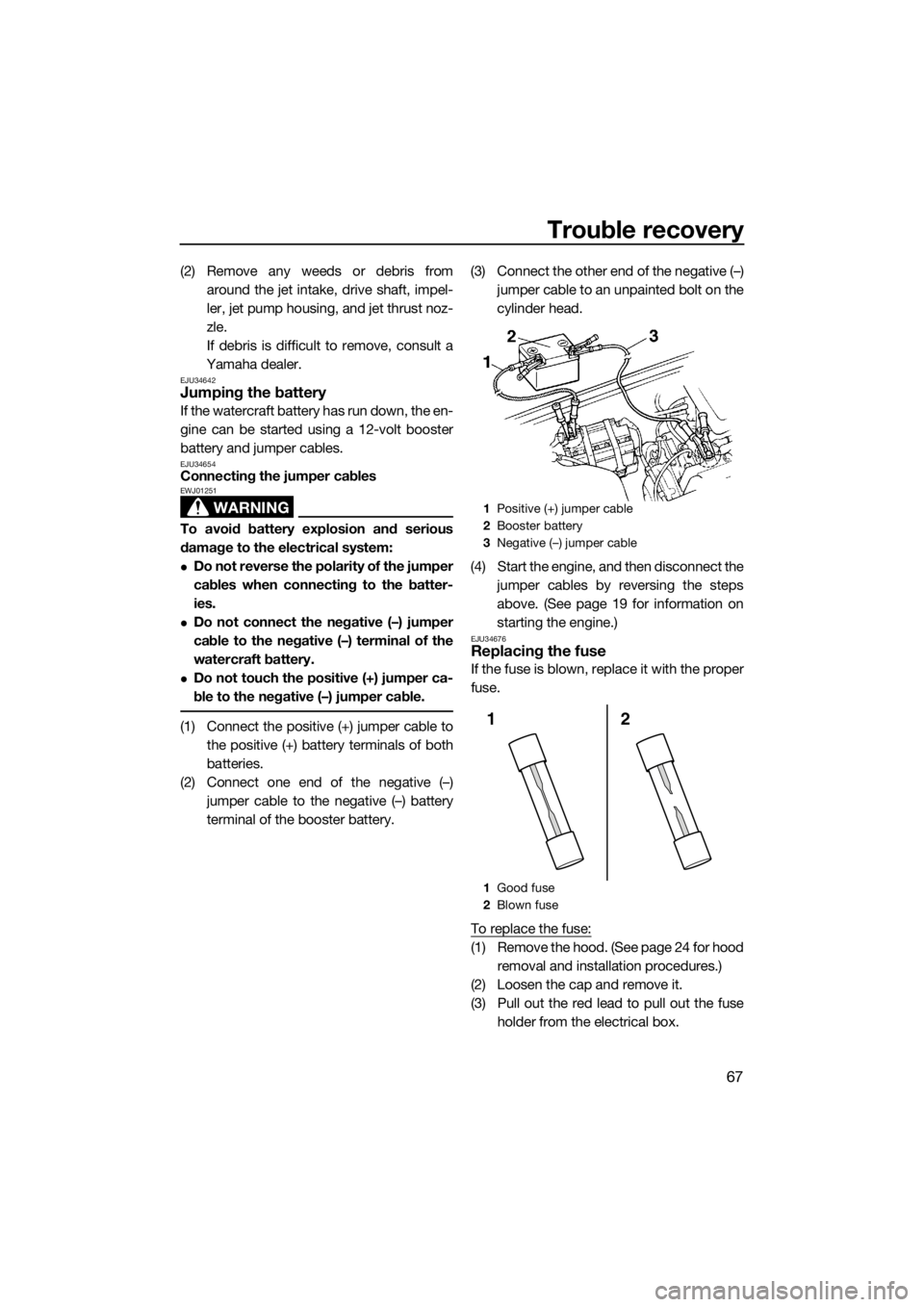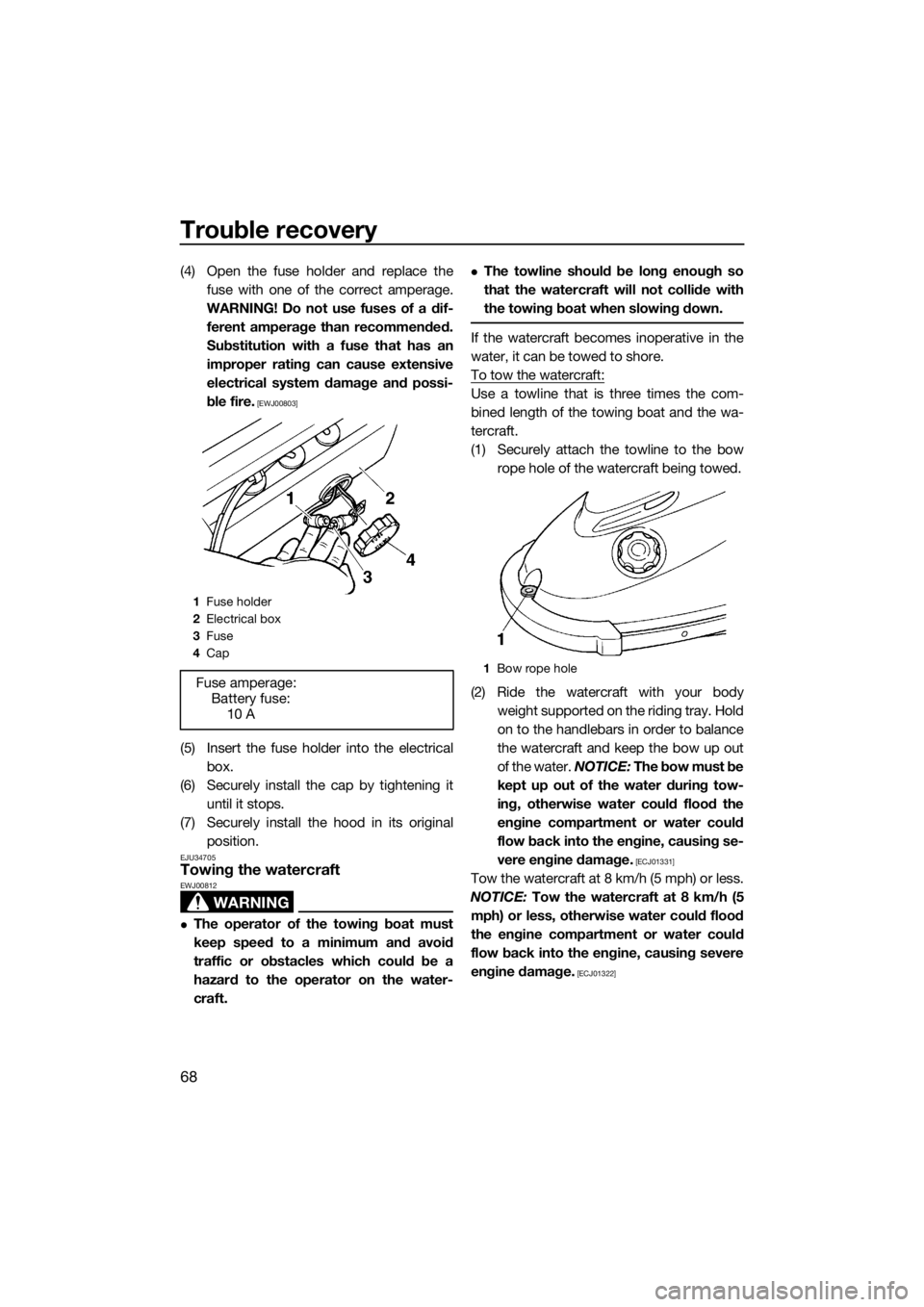YAMAHA SUPERJET 2014 Manual PDF
Manufacturer: YAMAHA, Model Year: 2014, Model line: SUPERJET, Model: YAMAHA SUPERJET 2014Pages: 78, PDF Size: 2.67 MB
Page 71 of 78

Trouble recovery
65
Engine runs irregu-
larly or stallsFuel Empty Refill as soon as pos-
sible29
Stale or contaminat-
edHave serviced by
Yamaha dealer—
Too much oil in fuel
mixing ratioCorrect fuel-to-oil ra-
tio to 50:128
Choke Knob is left pulled Push fully in 21
Fuel filter Clogged or water
pooledHave serviced by
Yamaha dealer61
Fuel tank Water or dirt present Have serviced by
Yamaha dealer—
Spark plug Fouled or defective Replace 60
Incorrect heat range Replace 60
Gap incorrect Replace 60
Spark plug
capNot connected or
looseConnect properly
60
Cracked, torn or
damagedHave serviced by
Yamaha dealer—
Electrical wir-
ingLoose electrical con-
nectionsHave serviced by
Yamaha dealer—
Carburetor Incorrect idle adjust-
mentHave serviced by
Yamaha dealer—
Clogged Have serviced by
Yamaha dealer61
Watercraft slow or
loses powerCavitation Jet intake clogged Clean 66
Impeller damaged or
wornHave serviced by
Yamaha dealer66
Engine over-
heatedJet intake clogged Clean
66
Fuel filter Clogged Have serviced by
Yamaha dealer61
Spark plug Fouled or defective Replace 60
Incorrect heat range Replace 60
Gap incorrect Replace 60
Spark plug
capsNot connected or
looseConnect properly
60
Fuel Stale or contaminat-
edHave serviced by
Yamaha dealer— TROUBLE POSSIBLE CAUSE REMEDY PAGE
UF2F76E0.book Page 65 Thursday, May 9, 2013 3:52 PM
Page 72 of 78

Trouble recovery
66
EJU34624
Emergency proceduresEJU34635Cleaning the jet intake and impeller
WARNING
EWJ00783
Before attempting to remove weeds or de-
bris from the jet intake or impeller area,
shut the engine off and remove the clip
from the engine shut-off switch. Severe in-
jury or death could result from coming in
contact with the rotating parts of the jet
pump.
If weeds or debris gets caught in the jet intake
or impeller, cavitation can occur, causing jet
thrust to decrease even though engine speed
rises. If this condition is allowed to continue,
the engine will overheat and may seize.
NOTICE: If weeds or debris gets caught in
the jet intake, do not operate the water-
craft above trolling speed until they have
been removed.
[ECJ00654]
If there is any sign that the jet intake or impel-
ler is clogged with weeds or debris, return to
shore and check the intake and impeller. Al-ways stop the engine before beaching the
watercraft.
(1) Place a suitable clean cloth or carpeting
underneath the watercraft to protect it
from abrasions and scratches. Turn the
watercraft on its side as shown.
NOTICE: Always turn the watercraft
over onto its port (left) side. When
turning the watercraft on its side, sup-
port the bow so that the handlebars
are not bent or damaged.
[ECJ00662]
STOP
UF2F76E0.book Page 66 Thursday, May 9, 2013 3:52 PM
Page 73 of 78

Trouble recovery
67
(2) Remove any weeds or debris from
around the jet intake, drive shaft, impel-
ler, jet pump housing, and jet thrust noz-
zle.
If debris is difficult to remove, consult a
Yamaha dealer.
EJU34642Jumping the battery
If the watercraft battery has run down, the en-
gine can be started using a 12-volt booster
battery and jumper cables.
EJU34654Connecting the jumper cables
WARNING
EWJ01251
To avoid battery explosion and serious
damage to the electrical system:
Do not reverse the polarity of the jumper
cables when connecting to the batter-
ies.
Do not connect the negative (–) jumper
cable to the negative (–) terminal of the
watercraft battery.
Do not touch the positive (+) jumper ca-
ble to the negative (–) jumper cable.
(1) Connect the positive (+) jumper cable to
the positive (+) battery terminals of both
batteries.
(2) Connect one end of the negative (–)
jumper cable to the negative (–) battery
terminal of the booster battery.(3) Connect the other end of the negative (–)
jumper cable to an unpainted bolt on the
cylinder head.
(4) Start the engine, and then disconnect the
jumper cables by reversing the steps
above. (See page 19 for information on
starting the engine.)
EJU34676Replacing the fuse
If the fuse is blown, replace it with the proper
fuse.
To replace the fuse:
(1) Remove the hood. (See page 24 for hood
removal and installation procedures.)
(2) Loosen the cap and remove it.
(3) Pull out the red lead to pull out the fuse
holder from the electrical box.
1Positive (+) jumper cable
2Booster battery
3Negative (–) jumper cable
1Good fuse
2Blown fuse
2 1
UF2F76E0.book Page 67 Thursday, May 9, 2013 3:52 PM
Page 74 of 78

Trouble recovery
68
(4) Open the fuse holder and replace the
fuse with one of the correct amperage.
WARNING! Do not use fuses of a dif-
ferent amperage than recommended.
Substitution with a fuse that has an
improper rating can cause extensive
electrical system damage and possi-
ble fire.
[EWJ00803]
(5) Insert the fuse holder into the electrical
box.
(6) Securely install the cap by tightening it
until it stops.
(7) Securely install the hood in its original
position.
EJU34705Towing the watercraft
WARNING
EWJ00812
The operator of the towing boat must
keep speed to a minimum and avoid
traffic or obstacles which could be a
hazard to the operator on the water-
craft.
The towline should be long enough so
that the watercraft will not collide with
the towing boat when slowing down.
If the watercraft becomes inoperative in the
water, it can be towed to shore.
To tow the watercraft:
Use a towline that is three times the com-
bined length of the towing boat and the wa-
tercraft.
(1) Securely attach the towline to the bow
rope hole of the watercraft being towed.
(2) Ride the watercraft with your body
weight supported on the riding tray. Hold
on to the handlebars in order to balance
the watercraft and keep the bow up out
of the water. NOTICE: The bow must be
kept up out of the water during tow-
ing, otherwise water could flood the
engine compartment or water could
flow back into the engine, causing se-
vere engine damage.
[ECJ01331]
Tow the watercraft at 8 km/h (5 mph) or less.
NOTICE: Tow the watercraft at 8 km/h (5
mph) or less, otherwise water could flood
the engine compartment or water could
flow back into the engine, causing severe
engine damage.
[ECJ01322]
1Fuse holder
2Electrical box
3Fuse
4Cap
Fuse amperage:
Battery fuse:
10 A1Bow rope hole
UF2F76E0.book Page 68 Thursday, May 9, 2013 3:52 PM
Page 75 of 78

Trouble recovery
69
EJU34735Submerged watercraft
If the watercraft is submerged or flooded with
water, drain the bilge water from the engine
compartment. Then, have a Yamaha dealer
service the watercraft as soon as possible.
(1) Remove the watercraft from the water,
and then remove the hood.
(2) Turn the fuel cock knob to “OFF”.
(3) Turn the watercraft over far enough to
drain the bilge water from the engine
compartment. NOTICE: Turning the
watercraft on its side with the hood
removed could cause damage to the
steering pole. Use two people to pro-
vide enough support to make sure
that the steering pole is not damaged.
[ECJ00702]
(4) Turn the watercraft upright again.
(5) Have the watercraft serviced by a
Yamaha dealer as soon as possible.
NOTICE: Be sure to have a Yamaha
dealer inspect the watercraft. Other-
wise, serious engine damage could
result.
[ECJ00792]
UF2F76E0.book Page 69 Thursday, May 9, 2013 3:52 PM
Page 76 of 78

Index
2-stroke engine oil ................................... 28
A
After removing the watercraft from the
water ..................................................... 49
B
Battery care.............................................. 51
Battery checks ......................................... 36
Battery, jumping ....................................... 67
Beaching the watercraft ........................... 49
Bilge water check..................................... 36
Bilge water, draining ................................ 30
Bilge water, draining on water ................. 30
Boarding and starting in deep water........ 47
Boarding and starting in shallow water.... 46
Bow rope hole .......................................... 25
C
Capsized watercraft ................................. 48
Carburetor, adjusting ............................... 61
Choke cable, adjusting ............................ 61
Choke knob.............................................. 21
Cleaning ................................................... 54
Cleaning the watercraft ............................ 51
Cooling water pilot outlet ......................... 21
Cooling water pilot outlet check .............. 39
Craft Identification Number (CIN)............... 1
Cruising limitations..................................... 9
E
Emergency procedures ............................ 66
Engine break-in ........................................ 32
Engine compartment check ..................... 35
Engine idling speed, adjusting ................. 62
Engine overheat warning system ............. 22
Engine serial number ................................. 1
Engine shut-off cord (lanyard) check ....... 38
Engine shut-off switch ............................. 19
Engine stop switch................................... 19
Engine unit check..................................... 36
Enjoy your watercraft responsibly............ 15
Equipment ................................................ 24
F
Fire extinguisher check ............................ 39
Fire extinguisher container....................... 26
Fire extinguisher container checks .......... 39
Flushing the cooling water passages....... 50Fuel .......................................................... 28
Fuel and engine oil requirements ............. 28
Fuel cock knob......................................... 21
Fuel filter, checking .................................. 61
Fuel level check........................................ 35
Fuel system checks ................................. 35
Fuel tank, filling ........................................ 29
Fuse, replacing ......................................... 67
G
Getting to know your watercraft .............. 40
Glossary, watercraft ................................. 16
H
Hazard information................................... 13
Hood ........................................................ 24
Hood check .............................................. 39
Hull and deck check ................................ 39
I
Identification numbers ............................... 1
J
Jet intake and impeller, cleaning.............. 66
Jet intake checks ..................................... 39
Jet thrust nozzle angle, adjusting ............ 57
Jumper cables, connecting ...................... 67
L
Labels, important ....................................... 3
Labels, other .............................................. 7
Labels, warning .......................................... 4
Launching the watercraft ......................... 41
Learning to operate your watercraft......... 40
Leaving the watercraft.............................. 43
Limitations on who may operate the
watercraft ................................................ 8
Long-term storage ................................... 54
Lubrication ............................................... 54
Lubrication points .................................... 61
M
Main components, location of ................. 17
Maintenance............................................. 56
Manufactured date label ............................ 2
Mixing fuel and oil .................................... 28
O
Operating in weeded areas ...................... 49
Operating positions .................................. 40
Operating the watercraft .......................... 43
Operating your watercraft ........................ 40
UF2F76E0.book Page 1 Thursday, May 9, 2013 3:52 PM
Page 77 of 78

Index
Operation requirements ........................... 10
P
Periodic maintenance chart ..................... 59
Post-launch checks ................................. 39
Post-operation care ................................. 50
Pre-launch checks ................................... 35
Pre-operation check points ..................... 35
Pre-operation checklist ............................ 33
Primary Identification (PRI-ID) number ...... 1
R
Recommended equipment ...................... 12
Rustproofing ............................................ 55
S
Safe boating rules .................................... 14
Safety equipment check .......................... 39
Spark plugs, checking ............................. 60
Start switch .............................................. 19
Starting off ............................................... 45
Starting the engine on water .................... 41
Steering friction, adjusting ....................... 56
Steering pole ............................................ 20
Steering pole check ................................. 37
Steering system ....................................... 20
Steering system checks ........................... 36
Stern rope hole ........................................ 25
Stopping the engine ................................. 43
Stopping the watercraft ........................... 45
Storage pouch ......................................... 25
Storage pouch checks ............................. 38
Submerged watercraft ............................. 69
Switch checks .......................................... 38
T
Throttle lever ............................................ 20
Throttle lever checks ................................ 37
Tool kit ..................................................... 56
Towing the watercraft .............................. 68
Transporting ............................................. 31
Troubleshooting ....................................... 64
Troubleshooting chart .............................. 64
Turning the watercraft .............................. 43
W
Water separator ....................................... 22
Water separator check............................. 36
Watercraft characteristics ........................ 13
Watercraft control functions .................... 19
UF2F76E0.book Page 2 Thursday, May 9, 2013 3:52 PM
Page 78 of 78

Printed on recycled paper Printed in Japan
June 2013–0.1 × 1 CR
UF2F76E0.book Page 1 Thursday, May 9, 2013 3:52 PM